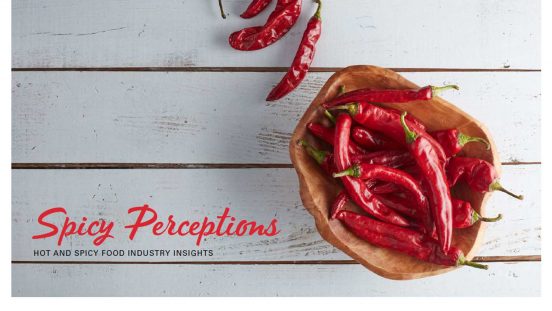Numbers on spicy food trends are hard to come by. When they exist, they are all the more interesting – certainly in the industry insights released by flavor-industry company Kalsec, Inc.
Kalsec used online surveys to ask 500 consumers each from Australia, Brazil, Canada, China, France, Germany, India, Italy, Mexico, Thailand, the UK, and the USA about their spicy food preferences.
Some of the results just support what was to be expected, some are telling. All are fascinating enough. A few are so noteworthy to me, I want to pick them out in this post.
Growth
First of all, they found that (interest in) spicy food consumption rose from 43% in 2017 to “over half” in 2019. Interest here means that spicy food options would be chosen, at restaurants or at home.
This alone is fascinating, as production/sales numbers for e.g. hot sauces aren’t widely available and seemed to indicate less growth recently than there had been a few years ago.
Preferences and Perceptions
Unsurprisingly, people overall said that they were more willing to try spicy flavors in sauces, main dishes, or snacks.
There was much more reluctance to try spicy beverages or desserts.
What Pungency is Good Pungency?
Neither a surprise: “Medium” heat levels turned out to be the most popular.
There are a few twists here which the presentation of results doesn’t address so explicitly, though:
Among the respondents, across all regions they separated – the Americas, Europe, and the Asia-Pacific – “no heat” was preferred by only 5% “in foods meant to be spicy” – the same number, in Europe and the Asia-Pacific, that wanted an extremely hot level of spiciness
Only 20% wanted such foods mild.
American Exceptionalism
“Extremely hot” was not uniformly at 5% of respondents, though. In the Americas, twice as many respondents, 10%, said that they wanted that level of hot.
Mexican respondents seem to have driven this trend, while US-Americans, Canadians, and Brazilians voted for medium heat. I still wonder if a bit of the fondness of American chileheads for “nuclear” and “extreme” hot sauces may not be reflected in that result, as well.
European Cond(iment)itions
Europe, of course, had to give some odd results:
“93% of UK consumers eat spicy foods at the dinner meal.”
“53% of Germans often choose spicy options when dining out at restaurants.”… and I wonder how this is even going to work when the vast majority of restaurants in Germany probably do not even have any spicy options.
German results made me laugh, anyways:
Germans were more likely to prefer “hot” spice levels than Brits, French, or Italians by a few percent… but Kalsec also tested the actual pungency of products:
The peak pungency of products labeled as “hot” in Germany proved to be half as high as that of “hot” products in Italy, and about one-quarter(!) as hot as those in the UK.
Heat, but What Heat?
The most interesting insight to me: This study found that the source of heat, the pepper varietals used, mattered to more than half of the respondents!
If you look around my blog here, you will (hopefully) find that this has long been a major topic of mine. It always seemed to be of little interest to anyone else, though!
There is more in the study, of course. For example about regional preferences and flavor combinations. I only wanted to share some – already many – highlights and thoughts, though, not “steal” the whole thing.
You can get / ask for the entire “eBook” (PDF) of “Spicy Perceptions” here.

Leave a Reply
You must be logged in to post a comment.